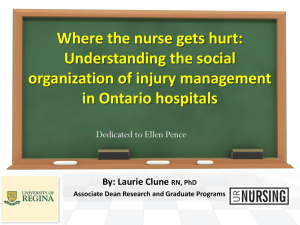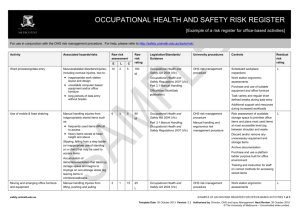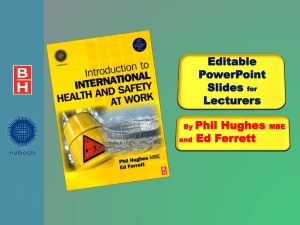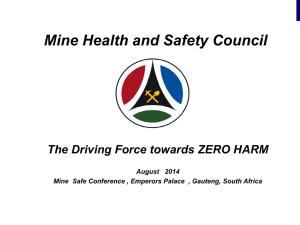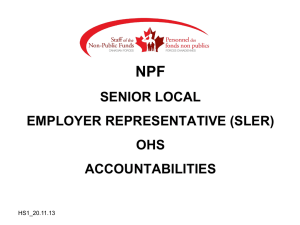Slayt 1 - OIC-VET
advertisement
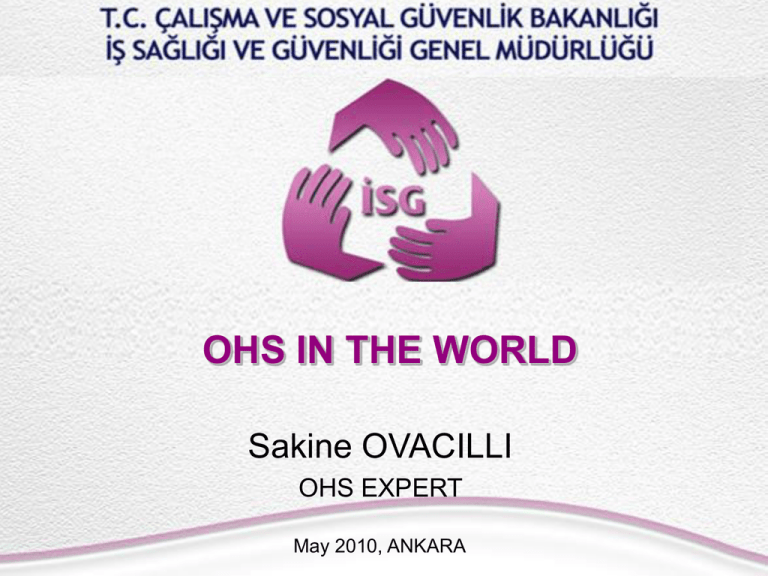
OHS IN THE WORLD Sakine OVACILLI OHS EXPERT May 2010, ANKARA CONTENT • • • • APPROACH LEGISLATION-EU STATISTICS KEY ACTORS – INTERNATIONAL ORGANISATIONS • ILO • WHO • EU-OSHA – GOVERNMENTAL BODIES • USA • UK • JAPAN APPROACH • Classical Approach: Aim is to ensure OHS – Defines measures in details – Based on standards – Reactive-obeying the rules • New Approach: Aim is to improve OHS – Basic Health and Safety Requirements – Standarts are voluntary – Proactive-prevention – Holistic APPROACH New Approach is a Holistic/Integrated Approach • OSH policy is not only a matter of laws and regulations they are essential and have to be applied at the workplace level. But to achieve measurable improvements of the working conditions and a reduction of occupational accidents and diseases it is necessary to combine them with a variety of other instruments, such as social dialogue, good practices, awareness raising, corporate social responsibility, economic incentives, mainstreaming. APPROACH New Terms With New Approach • Improving health and safety • Risk assessment • Prevention policy • Provision of information and training for employees • Involving and consulting employees • Cooperation of different employers at the same workplace APPROACH RISK ASSESSMENT A process to • Identify the hazards, • Assess the exposure level for hazards and peole at risk • Define the measures • Implement the decided measures • Follow up EUROPEAN LEGISLATION LIST OF EUROPEAN OHS LEGISLATION • 89/391/EC The OSH Framework Directive • Workplaces, equipment, signs, personal protective equipment • Exposure to chemical agents and chemical safety • Exposure to physical hazards • Exposure to biological agents • Provisions on workload, ergonomical and psychosocial risks • Sector specific and worker related provisions • New Approach Directives – Conformity – Safety of goods/products EUROPEAN LEGISLATION KEY POINTS OF RESPONSIBILITIES OF EMPLOYER • Employer is responsible to ensure OHS at workplace • Employer is responsible to control and follow the system to prevent accidents and diseases. • Employer should organise OHS services at workplace level • Employer can consult workplace physicians, occupational safety experts and other experts EUROPEAN LEGISLATION KEY POINTS OF RISK ASSESSMENT • RA should be repeated in the case of occupational accident or disease, any change in working methods, materials, equipments or at least periodically. • Effectiveness of measures should be monitored periodically • RA should be documented and the results should be followed. • Each employees should be involved. • Vulnarable workers including women, young, disabled workers and long-term effects of hazards should be considered in RA. STATISTICS-EU They do not tell the whole story, but statistics are an essential part of any analysis of safety and health issues. They reveal, for example, the following truths: STATISTICS-EU • Every year 5,720 people die in the European Union as a consequence of work-related accidents, according to EUROSTAT figures. • Besides that, the International Labour Organisation estimates that an additional 159,500 workers in the EU die every year from occupational diseases. STATISTICS-EU Taking both figures into consideration, it is estimated that every three-and-a-half minutes somebody in the EU dies from work-related causes. STATISTICS-GLOBAL Recent Global Estimates of ILO Each year in the world • 358,000 fatal occupational accidents • 337 million non-fatal occupational accidents occurs and • 1.95 million people die from work-related diseases MAIN ACTORS IN OHS – INTERNATOINAL ORGANISATIONS • ILO • WHO • EU-OSHA – GOVERNMENTAL BODIES • USA • UK • JAPAN MAIN ACTORS IN OHS – INTERNATIONAL ORGANISATIONS • ILO • WHO • EU-OSHA ILO • The International Labour Organization (ILO) is the “tripartite” United Nations agency • brings together governments, employers and workers of its member states in common action • to promote decent work throughout the world ILO Main aims of ILO are to • promote rights at work, • encourage decent employment opportunities, • enhance social protection and • strengthen dialogue in handling workrelated issues ILO KEY ACTIVITIES FOR OHS • • • ILO World Day for Safety and Health at Work In 2003, the ILO began to observe World Day stressing the prevention of illness and accidents at work on every 28 April, capitalizing on its traditional strengths of tripartism and social dialogue. 28 April is also a day the world's trade union movement has long associated with commemorating victims of occupational accidents and disease. The World Day for Safety and Health at Work 2010: Emerging risks and new forms of prevention in a changing world of work ILO Periodicals, statistics, database, publications and researches ILO KEY ACTIVITIES FOR OHS Supporting OHS WORLD CONGRESS XIX World Congress on Safety and Health at Work 11-15 September 2011, Istanbul, Turkey http://www.safety2011turkey.org/ ILO KEY SOURCES FOR OHS • ILO-CIS CENTER: International Occupational Safety and Health Information Centre is the knowledge management arm of ILO • Program on Safety and Health at Work and the Environment (SafeWork): Its goal is to ensure to the facts needed to prevent occupational injuries and diseases. • Encyclopedia of Occupational Health and Safety • Global Strategy on Occupational Safety and Health • Promotional Framework for Occupational Safety and Health • ILO-OSH 2001 Guidelines on OSH management systems • List of occupational diseases annexed to Recommendation No. 194, 2002 WHO IS A WORL WIDE ORGANISATION WHO:World Health Organisation • WHO is the directing and coordinating authority for health within the United Nations system. It is responsible for providing leadership on global health matters, shaping the health research agenda, setting norms and standards, articulating evidence-based policy options, providing technical support to countries and monitoring and assessing health trends. WHO KEY ACTIVITIES WHO KEY SOURCES • • • • • www.who.int/en/ Experts’ health guidelines Standards, Support and promotion health research Global Plan of Action on Worker’s health 2008 2017 EU-OSHA • European Agency for Health and Safety at Work • Set up in 1996 by the European Union • EU-OSHA is the main EU reference point for safety and health at work. • Main target is to be the central provider of quality OHS information for making Europe healthier, safer, more competitive and more productive place to work for every user, regardless of size of enterprise or sector of activity. MAIN ACTIVITIES • Awareness-raising activity is the Healthy Workplaces campaign, which focuses on a different theme every two years. – 2008-2009: Risk Assessment – 2010-2011: Safe Maintenance • Good Practice Examples • Analysis of scientific research and statistics MAIN ACTIVITIES • Focal points networking: Network of representatives of government, employees and employers from EU-MS, EFTA, Candidate, Potential Candidate Countries – contribute to the Healthy Workplaces campaign, – manage national websites – nominate representatives to Expert Groups. KEY SOURCES • Access to Focal Point Websites • Publications • Good practice examples and practical solutions • Campaigns websites • Statistics • Organisation and strategies: Community Strategy for Health and Safety at Work, 2007-2012 EU OSHA WEBSITE MAIN ACTORS IN OHS – GOVERNMENTAL BODIES • USA • UNITED KINGDOM • JAPAN USA - DOL • Department of Labor: http://www.dol.gov • The Department of Labor fosters and promotes the welfare of the job seekers, wage earners, and retirees of the United States by improving working conditions, advancing their opportunities for profitable employment, protecting their retirement and health care benefits, helping employers find workers, strengthening free collective bargaining, and tracking changes in employment, prices, and other national economic measurements. USA-DOL • In carrying out this mission, the Department administers a variety of Federal labor laws including those that guarantee workers’ rights to safe and healthful working conditions; a minimum hourly wage and overtime pay; freedom from employment discrimination; unemployment insurance; and other income support. USA-OHS STRATEGY • Strategic Plan for Fiscal Years 2010-2016 Strategic Goal 1: Reduce occupational hazards through direct interventions Strategic Goal 2: Promote a safety and health culture through compliance assistance, cooperative programs and strong leadership Strategic Goal 3: Maximize effectiveness and efficiency by strengthening capabilities and infrastructure USA-OSHA Occupational Safety & Health Administration provide statistics, standards, publications, guidance, training documents, advicing about OHS Departments: • • • • • • • • Directorate of Administrative Programs (DAP) Directorate of Construction (DOC) Directorate of Cooperative and State Programs Directorate of Training and Education Directorate of Enforcement Programs Directorate for Evaluation and Analysis Directorate of Information Technology Directorate of Technical Support and Emergency Management Directorate of Standards and Guidance KEY SOURCES-OSHA Occupational health and safety act (1970) OSHA:http://www.osha.gov/ National Institute for Occupational Safety & Health (NIOSH) – important research Institution eTools Safety and Health Topics Pages NIOSH Health Hazard Evaluation Program On-site Consultation Program compliance assistance Record keeing and standards (sector/risk oriented) UNITED KINGDOM-HSE • The Health and Safety Executive (HSE) administers the UK Focal Point, supported by HSE Northern Ireland (HSENI), the social partners and others. • Mission: The prevention of death, injury and ill health to those at work and those affected by work activities • Activities: Legislation, inspection, proggrammes about OHS UK-HSE DEPARTMENTS • Resources Planning Directorate • Strategy and Intelligence Division • Operational Policy Division • Local Authority Unit • Nuclear Safety Directorate • Hazardous Installations Directorate • Science and Technology Group • Field Operations Directorate • Chief Scientific Adviser's Group – Science Strategy and Research Division – Corporate Science Unit – Analytical Services Division – Statistics Branch – Economic Analysis Unit – Social Science Unit UK-POLICY AND STRATEGY • Health and Safety at Work etc. Act 1974 • The legislation has at its heart a simple but enduring principle – those who create risks are best placed to control them. • HSE's strategy recognises that the changing world presents new challenges for the health and safety system as a whole, and sets out to address them. UK-OHS STRATEGY • • • • • • • • • • • Priorities The pressures to improve Everyone has a role Investigations and securing justice The need for strong leadership Building competence Involving the workforce Creating healthier, safer workplaces Customising support for SMEs Taking a wider perspective Driving change for the better UK-KEY SOURCES • www.hse.gov.uk • Strategy document: The Health and Safety of Great Britain- Be part of the solution • Business plan 2010/11 • Campaigns: Stress, Diseases reduction… • Legislations • Researchs • Publications • Sector and risk based classifications of information on website JAPAN • Ministry of Labour, Health and Welfare • Japan International Center for Occupational Safety and Health (JICOSH) • National Institute of Occupational Safety and Health (JNIOSH) JP-Ministry of Labour, Health and Welfare Ministry of Labour, Health and Welfare • Main working fields on OHS – Inspection – Legislation and Policy Making – Social Security – Statistics • Department for OHS: Industrial Safety and Health Department JP-JNIOSH • National Institute of Occupational Safety and Health • independent administrative institution since 2001, (before under the Ministry) • Main Tasks – Research : Safety, health, environment Mechanical/Construction/Electrical/Psychosocial risks, – Promotion, Publication, Providing Information and expertise • http://www.jniosh.go.jp/en/ JP- JICOSH • Japan International Center for Occupational Safety and Health (JICOSH) JICOSH was established to provide companies and others with safety and health information concerning various countries, to help contribute Japan's experience in safety and health technology and knowhow to the broader international society, and to sponsor seminars to encourage such exchanges International cooperation • http://www.jicosh.gr.jp/ JAPAN • Japan Industrial Safety and Health Association (EU-OSHA FP Member) JISHA aims to improve the standards of industrial safety and health by promoting voluntary activities by employers and other people concerned in the private sector, thus eliminating industrial accidents and occupational diseases and realising high quality of life at work JP-POLICY AND STRATEGY • Creating an environment where people can work with a strong motivation and a sense of security as well as in good health • Japanese OHS Act: Law for workers' safety and health, 1972 • Priorities – Small and self-employed workplaces – New and emerging risks with taking the changing world of economy and business rather than traditional risks. – Women workers due to demographic changes. USA-UK-JAPAN All • have OHS act • have information and research center • use produced information to form strategy and policies and safety culture • priorities focused on prevention by different • approachs, methods • governmental organisation structure Sakine OVACILLI sbuyukguclu@csgb.gov.tr www.isggm.gov.tr
